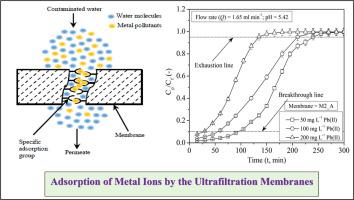Chemical Engineering Journal ( IF 15.1 ) Pub Date : 2020-06-27 , DOI: 10.1016/j.cej.2020.126036 Somen Mondal , Subrata Kumar Majumder

|
The polysulfone-based ultrafiltration membranes were synthesized by the phase inversion method with the varying ratios of composites for the efficient removal of heavy metal ions from their contaminated solutions. The membranes were characterized in terms of porosity, permeability, average pore size, contact angle, zeta potential, flux regeneration, and mechanical strength. The surface morphology of the membranes were analyzed by the field emission scanning electron microscope. The fluxes of the membranes were tested at the different transmembrane pressures of 1.5–3.5 kg cm−2. The lead ion (Pb2+) removal efficiencies of the membranes were investigated for the solutions of initial concentration 50 mg L-1 at a fixed pH value of 5.42. The effect of the feed concentrations on the overall adsorption capacity was investigated by varying the initial feed concentrations from 50 to 200 mg L−1. The highest adsorption capacity was obtained as 279.63 mg g−1 for the feed concentration of 200 mg L−1, and the permeate flux of 1.65 mL min−1. However, the lower feed concentration and the lower flux were advantageous for the long time functioning of the membrane with its higher efficiency without regeneration. The breakthrough curves for the Pb2+ adsorption processes were generated, and the experimental results were compared with the Thomas model. A mixture of heavy metal ions contaminated solutions was passed through the most appropriate membrane (in terms of adsorption capacity) to investigate the effect of co-existing metal ions on the adsorption capacities of lead ions. The removal efficiencies of the membrane for the different metal ions followed the trend like Pb2+ > Cu2+ > Cd2+ > Fe2+.
中文翻译:

基于聚砜的复合超滤膜的制备,用于从受污染的水溶液中吸附去除重金属离子
通过相转化方法合成了基于聚砜的超滤膜,其中不同比例的复合物可以有效地从污染溶液中去除重金属离子。该膜的特征在于孔隙率,渗透率,平均孔径,接触角,ζ电势,助焊剂再生和机械强度。通过场发射扫描电子显微镜分析膜的表面形态。在1.5–3.5 kg cm -2的不同跨膜压力下测试膜通量。对于初始浓度为50 mg L -1的溶液,研究了膜的铅离子(Pb 2+)去除效率在5.42的固定pH值下。通过将初始进料浓度从50 mg L -1改变为200 mg L -1,研究了进料浓度对总吸附能力的影响。进料浓度为200 mg L -1时的最高吸附容量为279.63 mg g -1,渗透通量为1.65 mL min -1。但是,较低的进料浓度和较低的通量有利于膜的长时间运行,并具有较高的效率而无需再生。Pb 2+的突破曲线产生了吸附过程,并将实验结果与托马斯模型进行了比较。受重金属离子污染的溶液的混合物通过最合适的膜(就吸附能力而言),以研究共存金属离子对铅离子吸附能力的影响。膜对不同金属离子的去除效率遵循Pb 2+ > Cu 2+ > Cd 2+ >的趋势 铁2+。



























 京公网安备 11010802027423号
京公网安备 11010802027423号